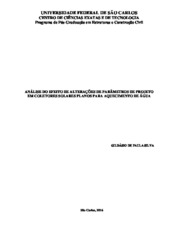| dc.contributor.author | Silva, Gildásio de Paula | |
| dc.date.accessioned | 2017-04-19T14:23:55Z | |
| dc.date.available | 2017-04-19T14:23:55Z | |
| dc.date.issued | 2016-08-29 | |
| dc.identifier.citation | SILVA, Gildásio de Paula. Análise do efeito de alterações de parâmetros de projeto em coletores solares planos para aquecimento de água. 2016. Dissertação (Mestrado em Engenharia Civil) – Universidade Federal de São Carlos, São Carlos, 2016. Disponível em: https://repositorio.ufscar.br/handle/ufscar/8632. | * |
| dc.identifier.uri | https://repositorio.ufscar.br/handle/ufscar/8632 | |
| dc.description.abstract | The objective of this work is to present the manufacturing parameters of the solar
collectors, subject to modification, resulting in improved performance. A discretization of the
components of the solar collector was made, identifying the points that could be improved, the
importance of each one and its influence on the operation of the collector as a whole. These
modifications were simulated by means of a mathematical model, namely: the position of the
absorber surface; The distance between the absorber surface and transparent cover; The
relationship between thickness and width of the absorber surface. The EES (Engineering
Equation Solver) software was used to perform the simulation. The model that was
implemented in the EES was a flat solar collector of 1.0 m². After the simulation was carried
out, three prototypes were built, one with characteristics common to the collectors available in
the market and called the Standard and two more manufactured with the proposed
modifications. All the models were sent to the Thermal Efficiency test in a laboratory accredited
by INMETRO. The results of the simulation indicated that the change in the position of the
absorber surface shows an increase of 0.11 m² in the absorber area of the collector; The
computational simulation indicated that the increase in the distance between the absorber
surface and the transparent cover in the collectors generated an increase in heat loss from the
top of the collector of 0.058 W / m²K; The change of the thickness and width of the absorber
surface generated a reduction in the efficiency of 94% in the standard collector to 90% in the
proposed prototype. The combination of the mounting position and the distance between the
absorber surface and the cover showed a 5% increase in the energy production of this collector.
For the results of the laboratory tests it was observed that the prototype with the modifications
in the thickness and width of the absorber surface showed a decrease in its performance and the
prototype with the combination of the mounting position with the distance between the absorber
surface did not show an improvement in its performance , Which was contrary to the
mathematical model and whose explanation is due to the uncertainty of ± 2.92% of the
production line of the company supplying the prototypes. | eng |
| dc.description.sponsorship | Não recebi financiamento | por |
| dc.language.iso | por | por |
| dc.publisher | Universidade Federal de São Carlos | por |
| dc.rights.uri | Acesso aberto | por |
| dc.subject | Coletor solar | por |
| dc.subject | Desempenho | por |
| dc.subject | Simulação | por |
| dc.subject | Solar collector | eng |
| dc.subject | Performance | eng |
| dc.subject | Simulation | eng |
| dc.title | Análise do efeito de alterações de parâmetros de projeto em coletores solares planos para aquecimento de água | por |
| dc.type | Dissertação | por |
| dc.contributor.advisor1 | Barreto, Douglas | |
| dc.contributor.advisor1Lattes | http://lattes.cnpq.br/7369326190168139 | por |
| dc.description.resumo | O objetivo deste trabalho é apresentar os parâmetros de fabricação dos coletores
solares, passíveis de modificação, resultando na melhoria do desempenho. Foi feita uma
discretização dos componentes do coletor solar identificando os pontos passíveis de melhoria,
a importância de cada um e a sua influência no funcionamento do coletor como um todo. Essas
modificações foram simuladas por meio de um modelo matemático, a saber: a posição da
superfície absorvedora; a distância entre superfície absorvedora e cobertura transparente; a
relação entre espessura e largura da superfície absorvedora. Foi utilizado o software EES
(Engineering Equation Solver) para realizar a simulação. O modelo que foi implementado
no EES foi um coletor solar plano de 1,0 m². Após a realização da simulação foram
construídos três protótipos, sendo um com características comuns aos coletores disponíveis
no mercado e chamado de Padrão e mais dois fabricados com as modificações propostas.
Todos os modelos foram enviados para ensaio de Eficiência Térmica em laboratório
credenciado pelo INMETRO. Os resultados da simulação apontaram que a mudança na
posição da superfície absorvedora evidencia um acréscimo de 0,11 m² na área absorvedora
do coletor; A simulação computacional indicou que com o aumento na distância entre a
superfície absorvedora e a cobertura transparente nos coletores gerou um aumento na perda
de calor pelo topo do coletor de 0,058 W/m²K; A troca da espessura e largura da superfície
absorvedora gerou uma redução na eficiência de 94% no coletor padrão para 90% no
protótipo proposto. A combinação entre a posição de montagem e a distância entre
superfície absorvedora e cobertura evidenciou-se um incremento de 5% na produção de
energia desse coletor. Para os resultados dos ensaios laboratoriais foi observado que o
protótipo com as modificações na espessura e largura da superfície absorvedora apresentou
uma queda no seu desempenho e o protótipo com a combinação da posição de montagem
com a distância entre superfície absorvedora não apresentou uma melhora no seu
desempenho, o que contrariava o modelo matemático e que cuja explicação se deve a
incerteza de ±2,92% da linha de produção da empresa fornecedora dos protótipos. | por |
| dc.publisher.initials | UFSCar | por |
| dc.publisher.program | Programa de Pós-Graduação em Engenharia Civil - PPGECiv | por |
| dc.subject.cnpq | ENGENHARIAS::ENGENHARIA CIVIL | por |
| dc.ufscar.embargo | Online | por |
| dc.publisher.address | Câmpus São Carlos | por |
| dc.contributor.authorlattes | http://lattes.cnpq.br/3758558559712642 | por |
